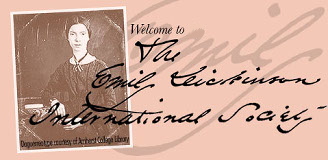
You are hereThe Dash
Submitted by Guest (not verified) on July 19, 2011 - 10:35am
This space is open to all EDIS members to share information about conference themes. Members can edit the page and comments are enabled. To make a comment, use your login and password. Enjoy the discussion!
|
Comments
The "Dash"
What do we mean when we call the marks Dickinson used in her poetry and in her letters "dashes"? What does "the dash" signify for us? What did it signify for her? What do we gain by thinking about it?
the dash
I was noticing today that in one of her inserts (in "I cried at pity"), Dickinson included dashes. That really gave it a kind of weight of intentionality to me. Check out the manuscript!
Dash it !
I'm always struck by the potential contradiction there is between the speed with which the word "dash" is associated and the fact that her dashes actually slow down our reading.
Or, conversely, they might speed things up on occasion. As when she writes: "Poets — All"
That's neatly concentrated, isn't it?
Three Questions
What is it about dashes??? Emphasis on manuscript study has created interest in Dickinson's marks that question the regularization of those into dashes that are uniform in representation.
How, where, whether do the dashes and other such marks influence interpretation of the poems?
How idiosyncratic or conventional are Dickinson's marks?
What's the relation between sight and sound? Do the visuals influence poems' meanings?
The Panelists
Beginning polemically, Cris Miller says that the writing out of the poem is the least stable of her poems. She believes that the most important, the core poem, is how it is heard. Dashes may emphasize pause, emphasis, whatever. Many nineteenth-century poets used the dash--Elizabeth Barrett Browning, Whitman, for example. Miller finds no particular coded significance of the dash.
Ellen Louise Hart speaks as a manuscript scholar and is especially interested in how the visual in fact influences the sound of poems. She believes the set of graphic symbols that Dickinson's uses signal changes in rhythm and metrics of poems. She also points out that the dash has been privileged over all of Dickinson's other graphic marks. "The syllable is the kingpin of sound" (Charles Olson). Her use of the dash changes and line breaks start to signal what dashes did a decade before. Her prosody changes.
The Panelists, cont'd
Peggy O'Brien says that punctuation takes place in time. "Commas blink, etc." The relationship to the dash to every single other element that is involved in poetry. Isolating the dash becomes futile. Absence of dashes tells us something about their presence.
Paul Crumbley begins by invoking some Webster's and some OED definitions of "dash." The dash increases readers' involvement in making meaning in the poems. He sees the dash as fundamentally democratic because of the way the reader has to decide what a dash, what dashes, mean. Exclusionary practices or binary oppositions are to be avoided. Differing readings can exist simultaneously. If there were a Bible of Emily Dickinson, it would have a single commandment--"Thou shalt not commit complacency." The dash discourages complacency.
the aural and the visual
The visual and the aural are not binary oppositions. That seems very clear. Check out http://www.emilydickinson.org/working/zhb32b.htm to see a very unusual dash.
The "dashes" are very different from one another.
User/PW
Tried to access this link, but it's asking for a username + password. Put in my EDIS website info., but that didn't work.
Any ideas?
Missed you all at the meeting this year (I'm home recovering from abdominal surgery -- ick!).
best,
~Connie Ann Kirk